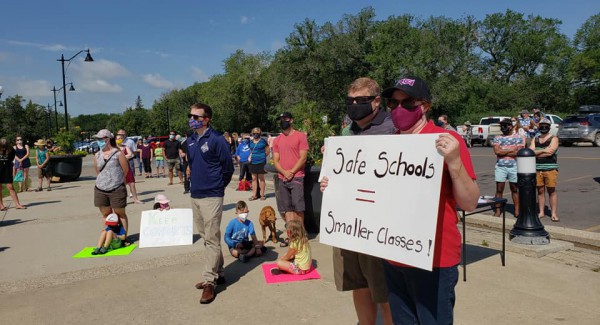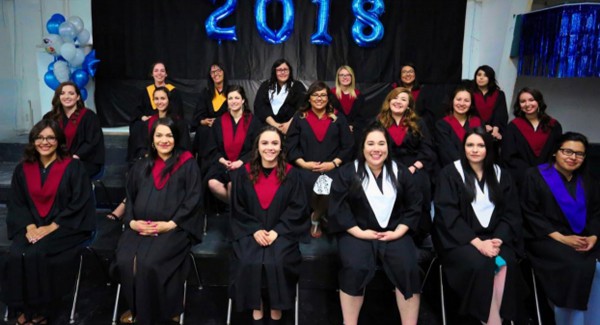Saskatchewan’s shameful sex ed

Reproductive Health Supplies Coalition/Unsplash
When it comes to sexual health, Saskatchewan leads the country in negative outcomes. From rates of sexually transmitted infections to teen pregnancy to sexual violence, the province is consistently ranked near or at the top. Given these statistics, it seems that the province would benefit from a robust sexual health education curriculum that emphasizes consent and how to have safe sexual encounters.
In practice, sexual health education is treated as a component of the broader health curriculum. There is no oversight from the Ministry of Health, and school boards are responsible for ensuring that students are receiving the necessary information. The system gives broad leeway to religious schools and socially conservative boards, which creates a patchwork system where some students get a better sexual health education than others. While the curriculum does indicate that students who engage in sex need information about effective protection against pregnancy and sexually transmitted infections, that same curriculum emphasizes that abstinence is “the best and healthiest decision” for adolescents. Sexual health educators in the province are left to fill in the gaps, but their presentations are only done by request – so, without access to every classroom in the province, their efforts aren’t enough to reverse the real harms caused by Saskatchewan’s current curriculum.
“If you look at the research, abstinence-only approaches have actually never proven to be effective – there has never been a research study that confirmed that they were successful in delaying sexual debut, which is the first time someone has sex, or lowering the risk of things like pregnancy or sexually transmitted infections."
Natalya Mason is the education and outreach coordinator at Saskatoon Sexual Health, a non-profit that provides sexual and reproductive health, education, and advocacy services. When asked about the current curriculum, Mason says, “If you look at the research, abstinence-only approaches have actually never proven to be effective – there has never been a research study that confirmed that they were successful in delaying sexual debut, which is the first time someone has sex, or lowering the risk of things like pregnancy or sexually transmitted infections. So just across the board, we’re pretty aware of the fact that they don’t do what they claim to do, and that they straight up don’t work.” The minister of education, Dustin Duncan, did not respond to a request for an interview about the province’s sexual health curriculum.
The most recent available statistics in Saskatchewan show that the lack of adequate sexual health education in the province is harmful to its residents. Saskatchewan residents contract HIV and hepatitis C at more than double the national averages: of every 100,000 people, 14.9 in Saskatchewan contract HIV, compared to the average of 6.9 throughout Canada, and 60.2 per 100,000 contract hepatitis C, compared to 30 in 100,000 Canada-wide. The province – in which one-quarter of children live in poverty – has almost three times the national rate of teen pregnancy: 23.7 in 1,000, compared to the Canadian average of 8.4 in 1,000.
If abstinence sex education were effective in achieving its goals, the province might be expected to have low rates of sexual harassment and assault, because people simply wouldn’t be forcing sexual interactions. In reality, Saskatchewan has the second highest rate of sexual violence out of all Canadian provinces. While education on consent, setting and maintaining healthy boundaries, and how to accept a “no” when someone rejects advances could help address our province’s second-place standing, they are not currently included in the curriculum.
Robin Hilton, the sexual health outreach coordinator with the University of Regina Students’ Union (URSU), says that the province’s sexual health curriculum isn’t preparing people for emotionally and physically safe sexual experiences. “What it’s doing is not preparing anyone to have a healthy sex life. What it’s doing is giving everyone a really skewed idea of what sex actually is, so as they go into adulthood – whether or not they’re abstaining until marriage – they come into their sex lives missing huge chunks of information about pleasure, about enjoyment, even about sexual communication and feeling comfortable talking about sex. There’s just so much that’s missing because it’s focused on the more negative outcomes.”
If abstinence sex education were effective in achieving its goals, the province might be expected to have low rates of sexual harassment and assault, because people simply wouldn’t be forcing sexual interactions. In reality, Saskatchewan has the second highest rate of sexual violence out of all Canadian provinces.
Hilton’s role is to provide sexual health information in the areas of safer sex practices, consent, relationships, and communication and pleasure to both staff and students at the University of Regina. In addition to putting on events with local educators and drag queens such as Flo Mingo, Hilton started a YouTube channel titled “Online Sex Ed with URSU,” where she covers topics like the history of the clitoris and how stress impacts sexual desire. She also explains that the topics she covers, and the questions addressed to her privately, are mainly on topics that Saskatchewan’s sexual health education curriculum does not cover.
A staple of Saskatchewan’s sex education is sex negativity; it focuses on the worst possible outcomes without offering much guidance on how to avoid or mitigate those outcomes, beyond abstaining from sex. Taryn Wahl, the education coordinator for Planned Parenthood Regina, explains that from a sex-positive perspective, only three things matter regarding sexual experiences: “the consent, well-being, and pleasure of everybody involved or affected by it.” Hilton says that neither consent nor pleasure are mentioned in the Saskatchewan curriculum at any grade level.
When working with young people, Wahl makes a point to begin with the concepts of pleasure and consent. “The reason I start with pleasure is as this building block for consent. What feels good for someone can change moment to moment, so we get into consent through verbally checking in, body language and what that looks like, communication skills and well-being, […] which is really all about respect and care for yourself and for the people you interact with.”
Wahl adds that some people who aren’t familiar with pleasure-focused sex education can get upset and assume that children are simply being taught how to masturbate. But as Wahl explains, “To me it makes no sense to talk about anxiety, depression, assault, unplanned pregnancy, or infections without talking about how to be able to feel good. What is anxiety and depression and all of those things? It’s feeling bad! So maybe pleasure is the word throwing people off, which happens. Certain words can hit us differently, but really what I’m talking about is that people want to feel good. Your body’s going to give you signals that help you figure that out, and you get to decide.”
Wahl explains that from a sex-positive perspective, only three things matter regarding sexual experiences: “the consent, well-being, and pleasure of everybody involved or affected by it.”
Mason mentions an approach known as “comprehensive sexuality education,” which has been championed by UNESCO. She says it’s considered by some educators to be the “gold standard” of this type of education. “It’s exactly what it sounds like,” Mason explains. “It’s sexuality education that’s comprehensive.” The approach covers topics like healthy relationships, gender identity, sexual violence, power, pleasure, faith, and culture, as well as risks like STIs and unwanted pregnancy and how to mitigate or avoid them. “It’s a more robust and holistic approach to teaching young people about sexuality education,” Mason says.
She adds that while there is no set standard for how sexual education must be taught or implemented in Canada, the Sex Information & Education Council of Canada (SIECCAN) produces guidelines that align with UNESCO’s comprehensive sexuality education. The guidelines carry weight because sexual education and reproductive rights are enshrined in human rights law, which Wahl says can include “comprehensive sex education where young people know all of the medically accurate information that they need to be able to be in control of their own sexual health.” While the education and outreach programs provided by Saskatoon Sexual Health and Planned Parenthood Regina do meet the standards held by both groups, Saskatchewan’s sexual health education curriculum does not.
To fill in the gaps of the curriculum, Saskatoon Sexual Health offers several programs, including one specifically for newcomers to Canada that has been translated into Mandarin and Tagalog, and another designed for those with developmental or intellectual disabilities in which individuals are educated on how to date, develop relationship skills, and navigate sexual relationships. At Planned Parenthood Regina, Wahl offers sexual education that includes information on various types of birth control and how they function, as well as gender and sexual orientations, non-traditional family types, and discrimination. While these programs fill broad educational gaps for those who have the opportunity to experience them, they are programs offered by request that require the sexual health educator to be physically present in person, or online for virtual presentations. That means the majority of people in Saskatchewan just don’t have access to this programming either because they don’t live near where the programming is provided, their school is not willing to bring sexual health educators in to teach, or they don’t know this programming exists in the first place.
Other organizations have also noticed the gaps in Saskatchewan’s sexual health curriculum and the health outcomes those gaps produce. An April 2020 report by the Community-University Institute for Social Research (CUISR) titled “Sexual Violence in Saskatchewan” investigated the current state of sexual assaults and supports available for survivors. The report recommended that Saskatchewan align its sexual education curriculum with the federal government’s Guidelines for Sexual Health Education. Those guidelines recommend education on indisputable sexual rights such as reproductive rights, as well as reaching seniors and individuals with disabilities. The CUISR report stresses the need for partnerships between schools and community-based organizations when it comes to providing adequate sexual education.
That means the majority of people in Saskatchewan just don’t have access to this programming either because they don’t live near where the programming is provided, their school is not willing to bring sexual health educators in to teach, or they don’t know this programming exists in the first place.
SIECCAN’s Canadian Guidelines for Sexual Health Education emphasizes that “Sexual health education should be presented by confident, well-trained, knowledgeable and nonjudgmental individuals who receive strong administrative support from their agency or organization.” Wahl stressed the importance of having sex educators who have personally worked through the shame and stigma our culture associates with sex; they say the educator’s personal biases and values will impact the type and quality of education that students receive, and if an educator – by choice or not – becomes uncomfortable while discussing topics, the students will likely remain uncomfortable as well. In their own practices as sexual health educators, Wahl, Mason, and Hilton invite questions, respond with empathy, and hold space for the values and beliefs of their students. But these aren’t necessarily innate characteristics; they are often skills that need to be developed and honed – which is difficult, if not impossible, when sexual health education isn’t a priority.
Wahl, Mason, and Hilton all note that in Saskatchewan, sexual health education is done by teachers who do not receive training on the topic within their degree programs. Wahl stresses that guidance is necessary because “[y]ou need to be able to address very serious questions and topics like sexual assault, homophobia, harassment, bullying, and abortion, and then you need to be able to bring [students] back to motivate them to not just be afraid, but empowered to handle these things, make choices, or know where to go for support for that. You also need to have very good boundaries and to be able to set them in front of an audience.”
“This job has been so challenging that it’s completely transformed who I am and I’m so grateful for that, but not everyone can do it because it’s so challenging. It’s triggering,” they continue. “When I talk to adults, whether they’re parents, teachers, or social workers and they want advice on how to talk to young people about sexuality, the first thing to consider is: what were your own experiences? How are you going to get triggered? Because you need to be able to deal with that.”
Mason says that when it comes to a robust sexual health curriculum, Saskatchewan doesn’t need to start from scratch – other countries like the Netherlands have already introduced evidence-based curricula in their classrooms. Wahl gives the example of the Dutch curriculum, “Butterflies in your Stomach,” where children as young as four are taught to communicate and respect boundaries, identify their bodily sensations, and to really sit and feel what having a crush is like. The Netherlands also made comprehensive sexuality education obligatory in 2012 as a core aspect of their approach for lowering HIV transmissions, and the country has seen the amount of newly reported HIV cases decrease consistently from 960 in 2010 to 270 in 2019. This approach yields benefits outside the area of STI prevention as well; the risk of an unplanned pregnancy for people ages 16–49 was 15.6 per cent in 2014 but had dropped to 7.1 per cent by 2020. The number of people under 21 giving birth is just three in every thousand, a stark contrast to Saskatchewan’s teen pregnancy birth rate of 23.7 in every thousand.
By the time many people make it to Planned Parenthood Regina or Saskatoon Sexual Health, they’re there to learn how to manage the consequences of being un- or undereducated.
Mason adds that the limitations on Saskatchewan’s sex education don’t end with the curriculum itself. “We really struggle with implementation and monitoring, which basically means that it’s entirely possible for kids to go through their entire school careers and never take sex ed because nobody was checking to make sure it was something that was being delivered,” she says. “Part of the issue is that teachers are apprehensive about teaching these lessons, either because they don’t feel like they have enough information themselves to be effective, or they’re worried about pushback from parents or administration.” While sexual health educators in Saskatchewan are working to bridge those gaps, their resources and their geographical reach are limited.
Saskatchewan cannot afford to continue with abstinence sexual health education while ignoring the health outcomes. The sexual health education programs offered by Planned Parenthood and Saskatoon Sexual Health are simply not enough to bridge the gaps left by schools; it is well-known by those who are paying attention that Saskatchewan’s decade-old curriculum isn’t achieving the goals of sexual health education, and there is no substitute for a robust curriculum. By the time many people make it to Planned Parenthood Regina or Saskatoon Sexual Health, they’re there to learn how to manage the consequences of being un- or undereducated.
Better access to adequate sexual health education is a mantle that should be picked up not only by parents and educators, but by anyone who has an interest in the health and well-being of the people in this province. The necessary components of a sex-positive, comprehensive curriculum are known, and there are people in this province who are willing and able to help implement a better approach. The question now is whether the Saskatchewan government will recognize this need and implement a better system for the province’s residents.
This story was published thanks to a solutions journalism reporting bursary. Reporting bursaries are supported by Journalists for Human Rights and the Solutions Journalism Network, and made possible by funding from the McConnell Foundation.



